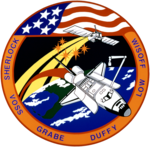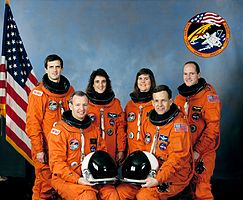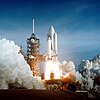STS-57
| Mission emblem | |||
|---|---|---|---|

|
|||
| Mission dates | |||
| Mission: | STS-57 | ||
| COSPAR-ID : | 1993-037A | ||
| Crew: | 6th | ||
| Begin: | June 21, 1993, 13:07:22 UTC | ||
| Starting place: | Kennedy Space Center , LC-39B | ||
| Landing: | July 1, 1993, 12:52:16 UTC | ||
| Landing place: | Kennedy Space Center, Lane 33 | ||
| Flight duration: | 9d 23h 44m 56s | ||
| Earth orbits: | 155 | ||
| Rotation time : | 93.5 min | ||
| Orbit inclination : | 28.4 ° | ||
| Apogee : | 483 km | ||
| Perigee : | 407 km | ||
| Covered track: | 6.6 million km | ||
| Team photo | |||
 v. l. No. Peter Wisoff, Brian Duffy, Nancy Currie, Janice Voss, Ronald Grabe, David Low |
|||
| ◄ Before / After ► | |||
|
|||
STS-57 ( english S pace T ransportation S ystem) is a mission designation for the US Space Shuttle Endeavor (OV-105) of NASA . The launch took place on June 21, 1993. It was the 56th space shuttle mission and the fourth flight of the space shuttle Endeavor.
team
- Ronald Grabe (4th space flight), commander
- Brian Duffy (2nd spaceflight), pilot
- David Low (3rd spaceflight), mission specialist
- Nancy Currie (1st Spaceflight), Mission Specialist
- Peter Wisoff (1st space flight), mission specialist
- Janice Voss (1st spaceflight), mission specialist
Mission overview
During the ten-day flight, the astronauts successfully carried out dozen of biomedical and materials science experiments in the Spacehab module, which demonstrated its space suitability on this flight. The experiment carrier EURECA (European Retrievable Carrier), which had been released by STS-46 a year earlier and contained several experiments, was captured by the crew and brought back to earth. Two space travelers performed a six-hour space exit .
Mission history
Due to an etched inspection number in a turbo pump in one of the three main engines of the space shuttle, the first official start date (June 3) at the end of May 1993 had to be canceled. This test number was in the wrong place on a spring inside the pump, which could have impaired its load capacity. It was decided to replace the high-performance pump and set June 20th as the new start date.
Low-hanging clouds and rain at the Kennedy Space Center as well as poor weather conditions at the emergency landing sites led to a 24-hour shift. The Endeavor finally took off on June 21, 1993 at 13:07:22 UTC. The countdown had to be stopped at 22 seconds because an aircraft was flying through the closed airspace.
Three and a half hours after take-off, the astronauts put the Spacehab module into operation in the ferry's hold. Built by the US company of the same name, it was rented from NASA to provide more space for experiments. The Spacehab is an extension of the shuttle middle deck and is connected to it via a tunnel. It is 2.8 meters long, 4.1 meters wide, 3.4 meters high and offers 30 cubic meters of space.
One of the most important tasks of the mission was the recovery and return of the European research platform EURECA . After the Endeavor entered orbit, Commander Ronald Grabe took up the chase. A series of orbit maneuvers later, EURECA was within range at the start of the fourth day of flight (June 24th).
At 12:08 UTC, the ESOC control center in Darmstadt, which was responsible for controlling the satellite, gave the order to fold the solar wings and 50 minutes later the two communication antennas were retracted. Both of the two-meter long booms could not be fully retracted. The reason for this could not be seen. Nevertheless, the capture maneuver continued and mission specialist David Low captured EURECA at 13:53 UTC with the robotic arm .
In order to supply the instruments and maintain the thermal control of EURECA, its four batteries were fully charged shortly before the solar cells were inserted. In addition, the 4.5-tonne experiment carrier was to be supplied via a power line specially installed on the robot arm until the power supply came from its holding platform in the payload bay. However, this “extension cable” did not work because (as it turned out after the flight) the plugs had been installed the wrong way round.
Houston received close-up images of the antennas half an hour after the capture, which the crew had taken at the request of the technicians. Nevertheless, a clear cause of the error could not be found. In the meantime, time was of the essence because EURECA ran out of electricity. The flight control decided to anchor the experiment carrier in the cargo hold and to advise later on how to proceed. At 16:43 UTC EURECA was finally deposited in its holder behind the Spacehab.
After intensive discussions by the engineers on the ground, the antenna problem was incorporated into the outboard activity planned for the next day. Analyzes had shown that there was no risk of a problem-free landing even if the antennas were left unlocked - they could not have hit dangerous areas in the cargo bay by swinging around.
The spacewalk (EVA) of the mission specialist David Low and Jeff Wisoff began on June 25 at 13:07 UTC. The two astronauts floated through the hatch in the connecting tunnel into the payload bay. The bulkheads of the Spacehab and the crew cabin had previously been closed and then the air from the lock and tunnel had been deflated.
First, a foot mount was installed at the end of the robot arm, which Low attached to. Then Nancy Currie maneuvered the RMS low to the satellite. Wisoff kept an eye on the space available, so that the arm didn't get anywhere. An hour into the EVA beginning, Low was in position to begin the antenna repair. The American and European technicians had worked out the procedures on the previous night shift. It was suspected that the insulation material protecting EURECA had expanded a little and prevented the two antennas from engaging. The task looked correspondingly simple: Low was only supposed to use muscle power to press the antennas against the satellite, while ESOC triggered the locking mechanism. After twenty minutes, the first boom was anchored on the third attempt. Sherlock repositioned the load arm with the help of Wisoff so that Low could easily reach the second antenna. Shortly thereafter, Low reported success here too.
The spacecraft completed the STS-57's primary objective of capturing the EURECA satellite. Then Low and Wisoff performed maneuvers for a shortened test of EVAs with the robotic arm. Investigations into the handling and fine alignment of masses as well as the application of high torques were carried out alternately by both crew members on the robot arm. Low and Wisoff completed their spacecraft shortly before 19:00 UTC after 5 hours and 50 minutes.
During the remainder of the mission, the crew worked on experiments in the Spacehab module in the shuttle's cargo bay. These experiments included posture studies, the spacecraft environment, crystal growth, metal alloys, wastewater recycling, and the behavior of liquids. Among the experiments was an assessment of maintenance tools intended for the Freedom space station (later the International Space Station ). The diagnostic tool part of the Tools and Diagnostic Systems Experiment was carried out by Nancy Currie. Using electronic test equipment including an oscilloscope , Currie undertook tests on a model circuit and communicated with ground control about suggested repair procedures and their results by computer.
In addition, Brian Duffy and Jeff Wisoff performed experiments on the transport of liquids without causing bubbles in the liquid in weightlessness. The "Fluid Acquisition and Resupply Experiment" or FARE experiment examined filters and procedures that could lead to methods of refueling a spacecraft in orbit and transported water between transparent tanks with a diameter of 0.6 meters in the middle deck of the Endeavor. This enabled engineers to study how the fluid behaved when the Endeavor fired its steering jets for small maneuvers. Janice Voss worked on the "Liquid Encapsulated Melt Zone" (LEMZ) experiment, which used a process called "floating zone crystal growth". The microgravity conditions allow large crystals to be grown in space.
Ron Grabe, Brian Duffy and Janice Voss took part in the "Neutral Posture Exam". Flight doctors noticed on previous flights that the basic posture of the body changes in microgravity. This change, sometimes called the "weightless squat," occurs in addition to the two-inch extension of the spine during space missions. In order to better document this phenomenon during the duration of a space flight, the crew members recorded photo and video material in a relaxed position at the beginning and at the end of the mission. Scientists are including these results in specifications for future spacecraft designs to make workstations and living areas more efficient and comfortable for astronauts.
Nancy Currie performed procedures to capture software ergonomics. She set up a work platform with a laptop and performed a simulated procedure for a space station propulsion system.
On June 28, 1993, Nancy Currie did improvised plumbing on the Environmental Control System Flight Experiment (EFE), an investigation into wastewater treatment that could potentially be used on board future spacecraft. EFE uses a mixture of water and potassium iodine to simulate dirty water. The solution is pumped through a series of filters to purify it. During the flight a reduced water flow could be observed by the experimenters and they decided to carry out the repair measure. For this purpose, Currie loosened a connection nozzle in the experiment, wrapped the now free nozzle with an absorbent diaper and let the pump of the experiment pump in the reverse direction for 20 minutes with the aid of a laptop in order to flush out the blockage. Currie then reattached the socket and the experiment could be continued by the experimenters on the ground under normal conditions.
The landing of the Endeavor had to be postponed on June 29 and 30, 1993 due to bad weather and took place after nine days, 23 hours and 45 minutes on July 1, 1993 at 12:52 UTC on runway 33 of the Kennedy Space Center .
See also
Web links
- NASA Mission overview (English)
- Video summary with comments of the crew (English)
- STS-57 in the Encyclopedia Astronautica (English)



